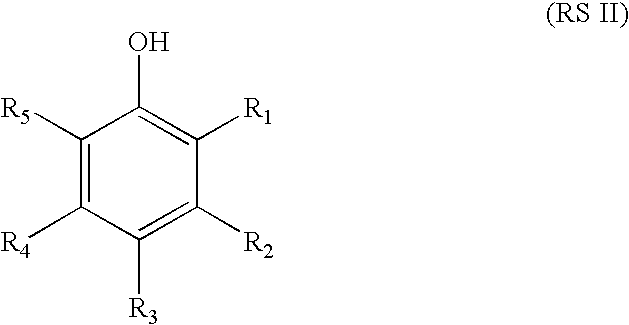Coloring agents for keratin fibers
a technology of keratin fibers and dyeing agents, which is applied in the direction of application, dyeing process, hair cosmetics, etc., can solve the problems of poor color evenness, low durability of direct dyes used here, and large number of requirements
- Summary
- Abstract
- Description
- Claims
- Application Information
AI Technical Summary
Benefits of technology
Problems solved by technology
Method used
Image
Examples
example 1
1-Step Procedure
Example 1a
2-[{4-[(4,5-dimethyl-1,3-thiazol-2-yl)diazenyl]phenyl}(ethyl)-amino]-N,N,N-trimethylethanaminium bromide (Standard azocoupling procedure)
[0078]11.5 g 2-amino-4,5-dimethyl-1,3-thiazol hydrochloride is dissolved in a mixture of 300 ml acetic acid and 10.2 g sulphuric acid while the temperature rises up to 30° C. The mixture is cooled to 15° C. followed by dropwise addition of 33.2 g 40% aqueous nitrosyl sulphuric acid and is stirred for 1.5 hours. In a separate beaker a solution of 20 g 2-[ethyl(phenyl)amino]-N,N,N-trimethylethanaminium bromide in a mixture of 80 ml acetic acid, 8.3 g hydrochloric acid and 120 g ice was prepared. The previously prepared diazonium salt solution was added slowly to this solution so that the temperature does not exceed 5° C. The solution is further stirred for 2 hours at room temperature. The pH value is adjusted to 4 by adding an appropriate amount of 30% aqueous sodium hydroxide. The resulted precipitate is filtered off, washe...
example 1b
2-[{4-[(4,5-dimethyl-1,3-thiazol-2-yl)diazenyl]-3-methylphenyl}(ethyl)amino]-N,N,N-trimethylethanaminium bromide
[0080]Analogously to the procedure described in example 1a, by azocoupling of 2-amino-4,5-dimethyl-1,3-thiazol hydrochloride with 2-[ethyl(3-methylphenyl)amino]-N,N,N-trimethylethanaminium bromide to give 2-[{4-[(4,5-dimethyl-1,3-thiazol-2-yl)diazenyl]-3-methylphenyl}(ethyl)amino]-N,N,N-trimethylethanaminium bromide in 55% yield.
[0081]1H NMR (300 MHz, DMSO): δ=7.70 (d, J=9.0, 1H, H(5)-phenyl); 6.77 (dd, J=9.0, J=2.7, 1H, H(6)-phenyl); 6.75 (d, J=2.7, 1H, H(2)-phenyl); 3.90 (m, 2H, N+CH2); 3.52 (m, 4H, 2×NCH2); 3.21 (s, 9H, 3×CH3); 2.57 (s, 3H, CH3); 2.37 (s, 3H, CH3); 2.31 (s, 3H, CH3); 1.18 (t, J=6.9, 3H, CH3).
example 1c
2-[{3-chloro-4-[(4,5-dimethyl-1,3-thiazol-2-yl)diazenyl]-phenyl}(ethyl)amino]-N,N,N-trimethylethanaminium methyl sulfate
[0082]Analogously to the procedure described in example 1a, by azocoupling of 2-amino-4,5-dimethyl-1,3-thiazol hydrochloride with 2-[(3-chlorophenyl)-(ethyl)amino]-N,N,N-trimethylethanaminium methyl sulfate to give 2-[{3-chloro-4-[(4,5-dimethyl-1,3-thiazol-2-yl)diazenyl]phenyl}(ethyl)-amino]-N,N,N-trimethylethanaminium methyl sulfate in 44% yield.
[0083]1H NMR (300 MHz, DMSO): δ=7.78 (d, J=9.3, 1H, H(5)-phenyl); 7.00 (d, J=2.4, 1H, H(2)-phenyl); 6.90 (dd, J=9.0, J=2.7, 1H, H(6)-phenyl); 3.92 (m, 2H, N+CH2); 3.55 (m, 4H, 2×NCH2); 3.19 (s, 9H, 3×CH3); 2.39 (s, 3H, CH3); 2.33 (s, 3H, CH3); 1.18 (t, J=6.9, 3H, CH3).
PUM
| Property | Measurement | Unit |
|---|---|---|
| pH | aaaaa | aaaaa |
| pKa | aaaaa | aaaaa |
| temperature | aaaaa | aaaaa |
Abstract
Description
Claims
Application Information
 Login to View More
Login to View More - R&D
- Intellectual Property
- Life Sciences
- Materials
- Tech Scout
- Unparalleled Data Quality
- Higher Quality Content
- 60% Fewer Hallucinations
Browse by: Latest US Patents, China's latest patents, Technical Efficacy Thesaurus, Application Domain, Technology Topic, Popular Technical Reports.
© 2025 PatSnap. All rights reserved.Legal|Privacy policy|Modern Slavery Act Transparency Statement|Sitemap|About US| Contact US: help@patsnap.com



